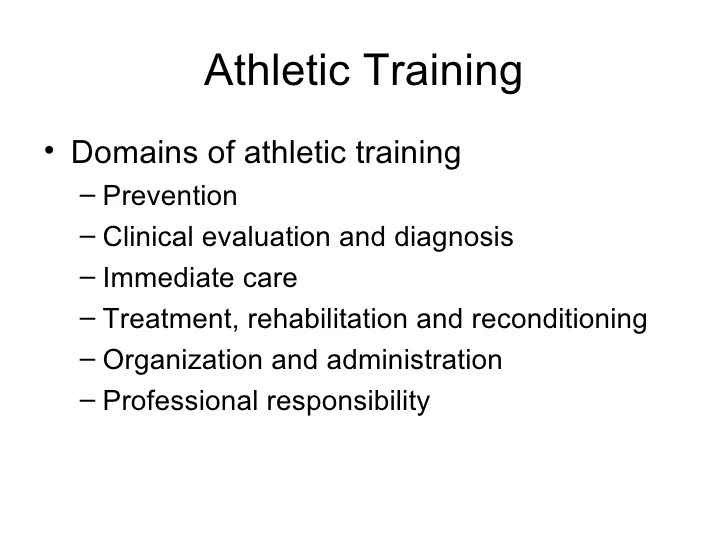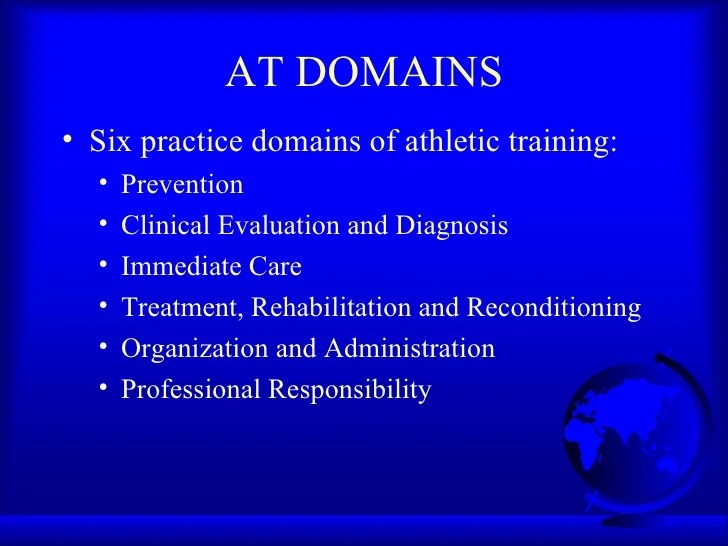The six domains of athletic training encompass a wide range of responsibilities and expertise that athletic trainers possess. These domains provide a framework for understanding the comprehensive role of athletic trainers in the prevention, care, and management of athletic injuries and the promotion of optimal athletic performance.
This article will delve into each domain, exploring the key aspects, common practices, and the vital contributions of athletic trainers in ensuring the well-being and success of athletes.
Definition and Overview
Athletic training encompasses a comprehensive range of healthcare services designed to prevent, manage, and rehabilitate injuries in athletes.
The six domains of athletic training, as defined by the National Athletic Trainers’ Association (NATA), provide a framework for the scope of practice:
- Prevention and Care
- Clinical Examination and Diagnosis
- Therapeutic Interventions
- Organization and Administration
- Professional Development and Research
| Domain | Key Aspects |
|---|---|
| Prevention and Care | Injury prevention strategies, first aid, and emergency care |
| Clinical Examination and Diagnosis | History taking, physical examination, and diagnostic testing |
| Therapeutic Interventions | Rehabilitation exercises, modalities, and taping techniques |
| Organization and Administration | Budget management, scheduling, and resource allocation |
| Professional Development and Research | Continuing education, research initiatives, and evidence-based practice |
Prevention and Care

Athletic trainers play a crucial role in preventing and managing injuries among athletes. They employ various strategies to reduce the risk of injuries, including:
- Educating athletes on proper training techniques
- Conducting pre-season screenings to identify potential risk factors
- Providing warm-up and cool-down protocols
- Monitoring athletes’ health and performance
When injuries do occur, athletic trainers are responsible for providing immediate care, such as:
- First aid
- Emergency care
- Immobilization and splinting
- Referral to appropriate medical professionals
Common injuries treated by athletic trainers include:
- Sprains and strains
- Concussions
- Fractures
- Dislocations
- Taking a detailed medical history
- Performing a physical examination
- Reviewing diagnostic tests, such as X-rays, MRIs, and CT scans
- Palpation
- Range of motion testing
- Manual muscle testing
- Neurological testing
- Functional movement assessment
- Rehabilitation exercises
- Modalities, such as heat, ice, and electrical stimulation
- Taping and bracing techniques
- Massage therapy
- Nutrition counseling
- Budget management
- Scheduling
- Resource allocation
- Compliance with regulations
- Collaboration with other healthcare professionals
Clinical Examination and Diagnosis: Six Domains Of Athletic Training

A comprehensive athletic training clinical examination involves:
Athletic trainers use various diagnostic tools and techniques to assess injuries, including:
Therapeutic Interventions

Athletic trainers employ a wide range of therapeutic interventions to rehabilitate injured athletes, including:
Rehabilitation exercises are designed to restore range of motion, strength, and function to injured tissues. Modalities are used to reduce pain, inflammation, and swelling. Taping and bracing techniques provide support and stability to injured areas.
Organization and Administration
Athletic trainers are responsible for the organizational and administrative aspects of athletic training programs, including:
Effective organization and administration ensure the efficient delivery of athletic training services and the safety of athletes.
Professional Development and Research
Continuing professional development is essential for athletic trainers to stay abreast of the latest advancements in the field. This includes attending conferences, workshops, and online courses.
Research is also an important aspect of athletic training. Athletic trainers contribute to the development of new knowledge and best practices through research initiatives and collaborations with other healthcare professionals.
Question & Answer Hub
What are the six domains of athletic training?
The six domains of athletic training include Prevention and Care, Clinical Examination and Diagnosis, Therapeutic Interventions, Organization and Administration, and Professional Development and Research.
What is the role of athletic trainers in injury prevention?
Athletic trainers play a crucial role in preventing injuries by conducting pre-participation screenings, providing injury prevention education, and implementing injury prevention programs.
What are some common diagnostic tools used by athletic trainers?
Athletic trainers utilize various diagnostic tools, including physical examinations, range of motion tests, palpation, and imaging techniques such as X-rays and MRIs.